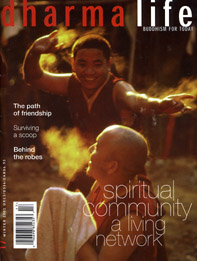The Life of Shabkar
The autobiography of a Tibetan Yogin
Trans. Matthieu Ricard
Suny Press 2001 (1994)
$29.95/£18.95 h/b
I may just be terminally dissatisfied and restless, but there is something in the myth of the wanderer that never fails to stir my blood. There is the dream of the road, the departure from home with no thought of return, the journeying in distant countries; the Buddha's Going Forth when he left his homeland for the forest because he saw that the household life was dusty, while the wanderer's life was full of freedom and wide expanses. These restless imaginings are never far away.
Beginning with the life of the Buddha himself, who spent 50 years travelling on foot through northern India, Buddhism has always been a religion of wanderers. Many biographies of the wandering saints and scholars of Buddhism are well known, but it is a particular pleasure to be introduced to a new traveller upon paths both real and metaphorical. Matthieu Ricard's translation of The Life of Shabkar, therefore, is to be welcomed.
There are many reasons why the publication of this volume should be a cause for celebration. Firstly, Shabkar is a little-known figure in the West, for all of his importance in the more recent history of Tibetan Buddhism. Secondly, it is such a glorious work, a huge fat book full of humour and wisdom in which Shabkar himself speaks of the pleasures and frustrations of the path with an uncompromising authenticity and a total lack of piety or preciousness. And finally, Ricard has done a remarkable job in making the book delightful, if not compulsive, reading.
Born in 1781 in Amdo, Shabkar demonstrated a desire for the religious life from an early age. He was ordained at the age of 20 and, rather than settle for a conventional monastic life, he left home to become a wanderer. The Life of Shabkar, his autobiography composed 14 years before his death in 1837, relates the story of his life and practice as he wandered through Tibet and Nepal, accompanied only by the walking stick which he referred to as his 'horse'. As Shabkar wandered from place to place, practising meditation, receiving initiations, taking on disciples of his own, he sang spontaneous songs of realisation, and these songs make up a large part of the text. Some of the songs celebrate the extraordinary freedom of his yogin's life:
I don't stay in one place now,
But go wandering across azure heavens.
The garuda's domain is the vast skies.
Other songs are fierce in their critique of the world that Shabkar sees around him:
Do rich people have arthritic,
crippled hands?
Why do I ask? Because when
beggars come
They are unable to open their
fists and give alms?
And Shabkar does not exempt himself, caricaturing himself as a 'pathetic old monk', for example in this song addressed to a passing bee:
All right, listen here, you lovely bee!
Your body's small; your buzz is loud.
My experience is feeble, but I have a
big mouth,
So you and I have much in common ...
There is much of Milarepa in Shabkar's autobiography, and indeed Milarepa was a strong influence on the imagination of Shabkar. Several songs in the autobiography are dedicated to Milarepa. But to my mind The Life of Shabkar is an altogether fresher and more exciting text than that of Milarepa. Shabkar is historically much closer to us, and his voice stands out as the voice of a real human being struggling with the difficulties of a life of practice. There are few of the miraculous happenings that occur in the life of Milarepa, these being replaced by a more human drama. Whether he is contemplating the sorrows of daily existence, teaching the Dharma to wild asses, casting demons out of his body by extruding them through his anus (an experience that leaves him feeling 'wobbly and strange') or making a pilgrimage to the great stupas of the Kathmandu valley, Shabkar is a riotous, profound, entertaining and sometimes alarming companion on the road.
Ricard's translation comes complete with six maps, four indexes, a detailed glossary, six appendices (including an extremely useful overview of the nine yanas that are classified within the Nyingma school), detailed notes, and a full bibliography - all of which will delight scholars. For the rest of us this enormous work should be a source of immense pleasure.
My advice is this: do not just read the book. Pack a rucksack, find yourself a stick, and with Shabkar as your companion, shake the household dust from your feet and venture forth - if only for a day. Even if only for an hour or two. You will not regret it.
Will Buckingam is currently writing his second novel



